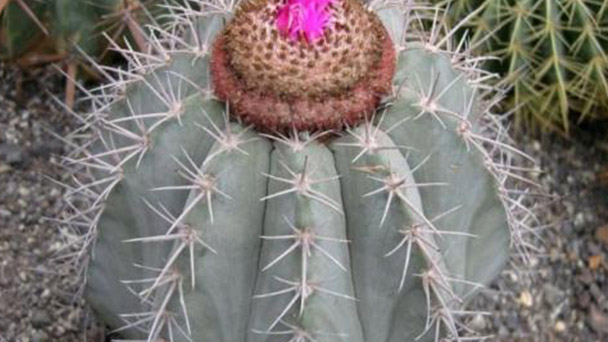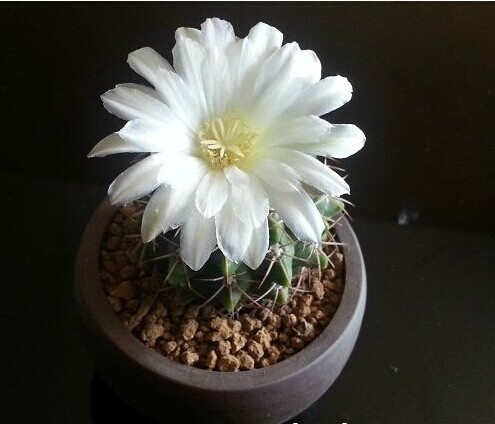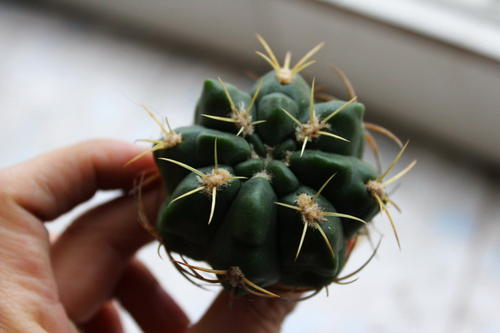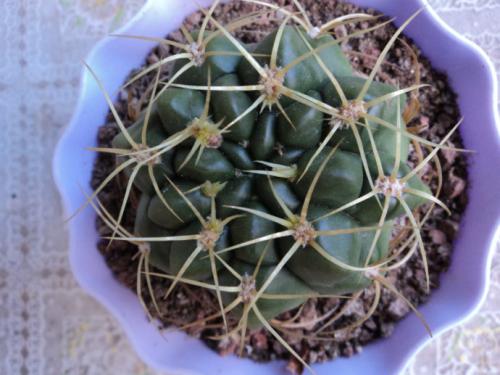Gymnocalycium marquezii profile
Written by Maggie
Mar 16 2021

Gymnocalycium marquezii belongs to the genus Gymocalycium in the family Cacti. Gymnocalycium marquezii has a flat bulb with grass green skin and light rose-red flowers. It is found in Bolivia.
Gymnocalycium marquezii, 4cm high and 10cm in diameter, with the grassy green epidermis, 8 ribs, divided by large nodules, 2 ~ 3cm in size. The spines have white felt hairs. The spines are 6 to 7, finely conical, 1 to 2.5cm long. The lower part is gray, and the upper part is reddish-brown. The flowers are a delicate (champagne flask), 4cm in diameter, pale rose-red with brown streaks in the middle.
Gymnocalycium Marquezii has pale and elegant skin color, beautiful flowers and thick thorns but not scattered. The rarest is in the artificial cultivation of good growth, is a very adaptable species. Greenhouse layout, exhibition display, assembly bonsai, landscape box gardening can be used, but the windowsill, the desk is also very appropriate.Gymnocalycium marquezii is a beautiful, large, spotless white flower that blooms in the fall and lasts a long time.
Gymnocalycium marquezii picture

Morphological characteristics of Gymnocalycium marquezii
Gymnocalycium marquezii belongs to the genus Gymocalycium of the Cacti family. It is oblate, 4cm high and 10cm in diameter. The epidermis is grassy green with 8 edges, divided by large tumor masses, which are 2 ~ 3cm in size. The spines have white felt hairs. The spines are 6 to 7, finely conical, 1 to 2.5cm long. The lower part is gray, and the upper part is reddish-brown. The flowers are a delicate (champagne flask), 4cm in diameter, pale rose-red with brown streaks in the middle.
The ovary and cone of Gymnocalycium marquezii have broad and blunt scales, and the floral axils are smooth. The genera Bonin and Groupridge have similar scales. But the Bonin flowers are bright yellow or purple with short tubes, while the Spines are in the depressions between the verrucae.
Ecological habits of the Gymnocalycium marquezii
Gymnocalycium marquezii is sun-loving, with terminal flowers, receptacles with large scales, but without hairs and spines. Most of the colors are not bright but elegant except for a few species.
Gymnocalycium marquezii has a continental climate and grows in dry areas with grassland vegetation and annual rainfall of about 500mm. Growing season basin soil moist, summer shade, strengthen environmental ventilation, winter basin soil dry, sufficient light, the temperature is not lower than 5℃.
Cultivation of Gymnocalycium marquezii
Gymnocalycium marquezii is one of the few species suitable for semi-closed cultivation, but the soil should be loose and fertile, the light should be sufficient, and the grafting should be on the measuring gauge. The initial growth is good, but the lower part is easy to age with time, so the roots must be taken out in time.
Unless something goes wrong in cultivation it will die, and the plant will bloom when it reaches a certain size. Due to the different growth environments of its place of origin, the planting environment and conservation conditions required by each species are also different.
Gymnocalycium marquezii grows well in a mixture of clay and humus soil. Some species are sensitive to excess moisture, so the soil needs to be well ventilated and loose. It is also important to note that the soil should be acidic, and in alkaline soil, the plants tend to turn yellow and look a little withered and dry yellow. In this case, the florist should be immersed in water with a pH of about 4.5.
Gymnocalycium marquezii is best suited to semi-shaded environments. For those with few spines, special care should be taken in the spring to shield them from the midday sun to avoid unsightly burn marks. Those grown in central and northwestern Argentina, and those from Uruguay and southern Brazil, need a certain amount of heat during the winter.
In general, gymnocalycium marquezii can take root and grow well, and those species with lateral buds can easily propagate through their lateral buds. But new seeds are often produced by sowing seeds, and in about three to four weeks a seedling will appear. While some species flower after 1-2 years, most species can not pollinate by themselves, after artificial pollination of the fruit grows well. Hybrids are also more likely to survive, but not as pretty as wild hybrids, and not as easy to maintain.
The propagation of Gymnocalycium marquezii
The propagation methods of Gymnocalycium marquezii were sowing, cutting and grafting.
The seeds can be pollinated by themselves and bear fruit. In the absence of seeds, the seeds must be forced by cutting off the top or digging out the "heart" because the seeds do not produce seeds for nothing.
The soil of Gymnocalycium Marquezii basin was mixed with two parts of peat and one part of coarse sand. Growing season basin soil moist, summer shade, strengthen environmental ventilation, winter basin soil dry, sufficient light, the temperature is not lower than 5℃.

Species classification of Gymnocalycium marquezii
Gymnocalycium marquezii is fond of flowering, and many breeders hybridize randomly. In China, Gymnocalycium marquezii is basically a hybrid variety, with few pure breeds. Even in the original place, there are many hybrid varieties, so the appearance will be very similar and it is difficult to distinguish.
Warbler usually has pink, white or yellow flowers. But unfortunately, this fancy flower will soon fade. In 1845 it was recognized as the first spherical cactus because of its unusual appearance. But you can recognize this genus by not looking at its flowers, which are usually oblate or oblate in shape, always rounded, and almost all of the spines have transverse furrows between them.
Gymnocalycium marquezii is the horticulture type of the Gymnocalycium marquezii variant, the sphere has yellow patches, the other same as the Gymnocalycium marquezii. In addition to the large varieties represented by Xintiandi, there are small species represented by Peony Jade.
Distribution of the Gymnocalycium marquezii
Gymnocalycium marquezii originated from South America, mainly distributed in Bolivia, Paraguay, Uruguay, southwest Brazil and Argentina. Because of its extensive regional origin, so it is not difficult to understand the shape of the signature.
Uses of Gymnocalycium marquezii
Ornamental value
Gymnocalycium Marquezii is lightly colored with beautiful flowers and thick but not scattered thorns. The rarest is in the artificial cultivation of good growth, is a very adaptable species.
Gymnocalycium marquezii is a worthy species to be cultivated. The large flowers and various thorns of Gymnocalycium marquezii are very attractive.
Garden use of Gymnocalycium Marquezii
Gymnocalycium Marquezii is suitable for greenhouse layout, exhibition display, assembling bonsai, landscape box gardening and so on. It is also suitable for windowsills and desks.

Latest Updated
- Benefits of Bugleweed - 7 Science-backed Health Benefits
- Bugleweed Dangers & Side Effects - Is It Poisonous?
- How to Plant Evergreen Trees - What You Should Know
- When to Plant Evergreens - Grow Guide for Evergreen Trees
- 12 Wonderful Evergreen Shrubs for Your Garden
- 12 Popular Evergreen Plants with Pictures for Beginners
- When And How To Prune A Lilac Bush Like a Pro
- How to Grow & Care for Lilac Vine (Hardenbergia Violacea)
- Japanese Lilac Tree (Syringa Reticulata) Care & Propagation Guide
- Shumard Oak Pros and Cons - What to Know
Popular Articles
- Winter maintenance of Antirrhinum Majus
- How to Grow Terminalia Mantaly Tree
- How to Grow and Care for Crossostephium Chinense
- How to grow Antirrhinum Majus in spring
- Peristeria Elata (Dove Orchid) Profile: Info & Care Guide
- Underwatered Snake Plant (Sansevieria Trifasciata) - Signs And How To Fix
- How to Care for Brazilian Jasmine Plant (Mandevilla Sanderi)
- How to Grow & Care for Graptopetalum Purple Delight in Summer
- Rosa Chinensis (China Rose): Plant Growing & Care Tips
- How to Care for Baby Sun Rose (Aptenia Cordifolia)